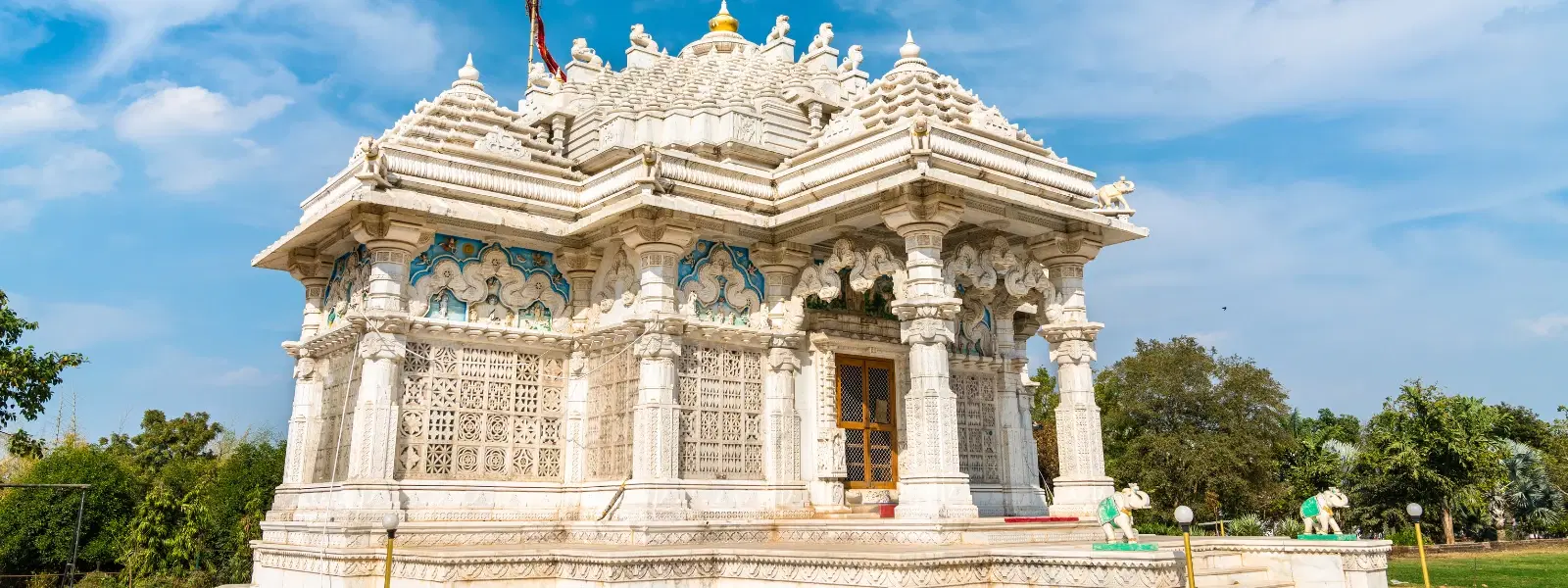
Hotels
•03 min read

The Hutheesing Jain Temple in Ahmedabad stands as a timeless marvel, where history and art converge in perfect harmony. Its intricate design, celebrated for its detailed stonework and majestic structure, never fails to awe visitors, inviting them on a journey through centuries of heritage and spirituality. This blog post explores the temple's architectural brilliance, answering frequently asked questions about its design, carvings, and cultural significance, so you can truly appreciate its artistic and historical value.
Built in 1848 by a prominent merchant family, the temple is dedicated to the 15th Jain Tirthankara, Dharmanatha. Its foundation not only reflects the prosperity of the era but also the deep religious devotion of its patrons. The temple’s construction is a blend of visionary planning and meticulous craft, setting the stage for what would become a cornerstone of Jain temple architecture in Ahmedabad.
The Hutheesing Jain Temple is more than a structure; it is a living heritage site. Over the years, it has earned respect not only as a place of worship but also as a vibrant symbol of Ahmedabad’s rich cultural fabric. Its continuous role in Jain practices, along with its appeal as a heritage icon, underscores the temple's lasting impact on the community. For Indians, this temple is a testament to the values of tradition and craftsmanship that span generations.
One of the temple’s most mesmerizing features is its Maru-Gurjara architectural style, a hallmark of exquisite intricate design. The temple is constructed predominantly with white marble, a material that has been revered in Jain temple architecture for its luminous quality and purity. The pristine marble not only enhances the temple's elegance but also reflects the spiritual purity that its architecture intends to convey.
Every corner of the Hutheesing Jain Temple speaks volumes about the exceptional craftsmanship of its creators. The pillar carvings, floral motifs, intricate geometric patterns, and depictions of revered Jain deities represent a fine blend of aesthetics and religious storytelling. This detailed sculptural artwork showcases the legacy of Jain temple craftsmanship and offers visitors a sensory experience that is as much about art as it is about devotion.

Standing at an impressive 78 feet, the Manastambha is a striking element of the temple’s design. Adorned with elaborate carvings, this pillar is more than a structural component—it is a symbol of the spiritual stature and aspirations of Jainism. Its design embodies the ornate features typical of Jain temples and serves as a proud beacon in the temple complex.
Beyond the majestic pillars, the temple boasts unique architectural highlights such as graceful domes, finely arched doorways, and detailed inlays that add to its overall allure. Every element from the soaring arches to the delicate stonework contributes to its status as an artistic masterpiece. The interplay of light on the white marble, the shadows cast by the intricate patterns, and the geometric precision all come together to create a visual symphony that resonates deeply with those who visit.
Maintaining the temple’s enduring beauty requires constant care. Over the years, dedicated conservation efforts have been implemented to safeguard the marble carvings and elaborate sculptures. Recognized as an important cultural and historical landmark, the Hutheesing Temple heritage site is meticulously preserved, ensuring that its architectural integrity remains intact for future generations to admire.
Today, the Hutheesing Jain Temple continues to draw visitors, pilgrims, and art enthusiasts from all over India. As a living testament to Ahmedabad’s rich past, it plays a crucial role in promoting heritage tourism. Whether you are a wanderer seeking inspiration, a planner searching for culturally enriching itineraries, or a professional looking to unwind in a legacy of art and history, this temple offers an experience that transcends the ordinary.
Did you know? The intricate stonework of Jain temples, including Hutheesing Jain Temple, is often compared to lacework due to its delicate and precise craftsmanship. This level of detail is a testament to the skill of ancient artisans.

The temple's design stands out for its Maru-Gurjara architectural style, intricate stone carvings, and use of white marble, which together create a visually stunning and spiritually significant structure.
The temple was built in 1848 by the Hutheesing family, a wealthy merchant family in Ahmedabad, as a dedication to the 15th Jain Tirthankara, Dharmanatha.
The Manastambha, or pillar of honor, is a 78-foot-high structure adorned with intricate carvings. It symbolizes the spiritual aspirations of Jainism and is a key architectural highlight of the temple.
The temple is maintained through conservation efforts that focus on preserving its intricate carvings and architectural features. It is also recognized as a cultural landmark in Ahmedabad.
The temple is a prime example of Ahmedabad's rich cultural and architectural heritage, attracting both pilgrims and tourists who wish to explore its historical and artistic significance.
The Hutheesing Jain Temple is a masterpiece that combines intricate design, artistic craftsmanship, and deep cultural significance. Its rich history, detailed sculptural work, and continuous role in preserving cultural heritage not only showcase the brilliance of Jain architecture but also immortalize Ahmedabad’s historical legacy. By exploring this landmark, you tap into a world where art meets devotion in the most enchanting manner.